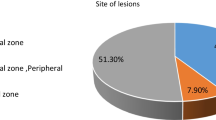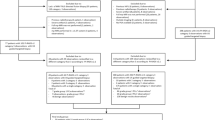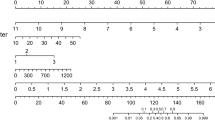Abstract
Purpose
To develop a prediction model to distinguish between transition zone (TZ) cancers and benign prostatic hyperplasia (BPH) on multi-parametric prostate magnetic resonance imaging (mp-MRI).
Materials and methods
This retrospective study enrolled 60 patients with either BPH or TZ cancer, who had undergone 3 T-MRI. We generated ten parameters for T2-weighted images (T2WI), diffusion-weighted images (DWI) and dynamic MRI. Using a t-test and multivariate logistic regression (LR) analysis to evaluate the parameters’ accuracy, we developed LR models. We calculated the area under the receiver operating characteristic curve (ROC) of LR models by a leave-one-out cross-validation procedure, and the LR model’s performance was compared with radiologists’ performance with their opinion and with the Prostate Imaging Reporting and Data System (Pi-RADS v2) score.
Results
Multivariate LR analysis showed that only standardized T2WI signal and mean apparent diffusion coefficient (ADC) maintained their independent values (P < 0.001). The validation analysis showed that the AUC of the final LR model was comparable to that of board-certified radiologists, and superior to that of Pi-RADS scores.
Conclusion
A standardized T2WI and mean ADC were independent factors for distinguishing between BPH and TZ cancer. The performance of the LR model was comparable to that of experienced radiologists.
Key Points
• It is difficult to diagnose transition zone (TZ) cancer.
• We performed quantitative image analysis in multi-parametric MRI.
• Standardized-T2WI and mean-ADC were independent factors for diagnosing TZ cancer.
• We developed logistic-regression analysis to diagnose TZ cancer accurately.
• The performance of the logistic-regression analysis was higher than PIRADSv2.





Similar content being viewed by others
Abbreviations
- BPH:
-
Benign prostatic hyperplasia
- PZ:
-
Peripheral zone
- T2WI:
-
T2-weighted images
- TZ:
-
Transition zone
References
Ahmed HU, Kirkham A, Arya M et al (2009) Is it time to consider a role for MRI before prostate biopsy? Nat Rev Clin Oncol 6:197–206
Akin O, Sala E, Moskowitz CS et al (2006) Transition zone prostate cancers: features, detection, localization, and staging at endorectal MR imaging. Radiology 239:784–792
Barentsz JO, Richenberg J, Clements R et al (2012) ESUR prostate MR guidelines 2012. Eur Radiol 22:746–757
Cagiannos I, Karakiewicz P, Eastham JA et al (2003) A preoperative nomogram identifying decreased risk of positive pelvic lymph nodes in patients with prostate cancer. J Urol 170:1798–1803
Chesnais AL, Niaf E, Bratan F et al (2013) Differentiation of transitional zone prostate cancer from benign hyperplasia nodules: evaluation of discriminant criteria at multiparametric MRI. Clin Radiol 68:e323–e330
Deering RE, Bigler SA, Brown M, Brawer MK (1995) Microvascularity in benign prostatic hyperplasia. Prostate 26:111–115
Dikaios N, Alkalbani J, Sidhu HS et al (2015) Logistic regression model for diagnosis of transition zone prostate cancer on multi-parametric MRI. Eur Radiol 25:523–532
Elbuluk O, Muradyan N, Shih J et al (2016) Differentiating transition zone cancers from benign prostatic hyperplasia by quantitative multiparametric magnetic resonance imaging. J Comput Assist Tomogr 40:218–224
Hoang Dinh A, Souchon R, Melodelima C et al (2015) Characterization of prostate cancer using T2 mapping at 3T: a multi-scanner study. Diagn Interv Imaging 96:365–372
Hoang Dinh A, Melodelima C, Souchon R et al (2016) Quantitative analysis of prostate multiparametric MR images for detection of aggressive prostate cancer in the peripheral zone: a multiple imager study. Radiology 280:117–127
Hoeks CM, Barentsz JO, Hambrock T et al (2011) Prostate cancer: multiparametric MR imaging for detection, localization, and staging. Radiology 261:46–66
Hoeks CM, Hambrock T, Yakar D et al (2013) Transition zone prostate cancer: detection and localization with 3-T multiparametric MR imaging. Radiology 266:207–217
Hoeks CM, Vos EK, Bomers JG, Barentsz JO, Hulsbergen-van de Kaa CA, Scheenen TW (2013) Diffusion-weighted magnetic resonance imaging in the prostate transition zone: histopathological validation using magnetic resonance-guided biopsy specimens. Investig Radiol 48:693–701
Jung SI, Donati OF, Vargas HA, Goldman D, Hricak H, Akin O (2013) Transition zone prostate cancer: incremental value of diffusion-weighted endorectal MR imaging in tumor detection and assessment of aggressiveness. Radiology 269:493–503
Katahira K, Takahara T, Kwee TC et al (2011) Ultra-high-b-value diffusion-weighted MR imaging for the detection of prostate cancer: evaluation in 201 cases with histopathological correlation. Eur Radiol 21:188–196
Kirkham AP, Emberton M, Allen C (2006) How good is MRI at detecting and characterising cancer within the prostate? Eur Urol 50:1163–1174, discussion 1175
McNeal JE, Redwine EA, Freiha FS, Stamey TA (1988) Zonal distribution of prostatic adenocarcinoma. Correlation with histologic pattern and direction of spread. Am J Surg Pathol 12:897–906
Ohori M, Kattan MW, Koh H et al (2004) Predicting the presence and side of extracapsular extension: a nomogram for staging prostate cancer. J Urol 171:1844–1849, discussion 1849
Othman AE, Falkner F, Weiss J et al (2016) Effect of temporal resolution on diagnostic performance of dynamic contrast-enhanced magnetic resonance imaging of the prostate. Investig Radiol 51:290–296
Padhani AR, Gapinski CJ, Macvicar DA et al (2000) Dynamic contrast enhanced MRI of prostate cancer: correlation with morphology and tumour stage, histological grade and PSA. Clin Radiol 55:99–109
Peng Y, Jiang Y, Antic T, Giger ML, Eggener SE, Oto A (2014) Validation of quantitative analysis of multiparametric prostate MR images for prostate cancer detection and aggressiveness assessment: a cross-imager study. Radiology 271:461–471
Pierson WR, Eagle EL (1969) Nomogram for estimating body fat, specific gravity and lean body weight from height and weight. Aerosp Med 40:161–164
Puech P, Sufana-Iancu A, Renard B, Lemaitre L (2013) Prostate MRI: can we do without DCE sequences in 2013? Diagn Interv Imaging 94:1299–1311
Siegel R, Naishadham D, Jemal A (2013) Cancer statistics, 2013. CA Cancer J Clin 63:11–30
Tamura C, Shinmoto H, Soga S et al (2014) Diffusion kurtosis imaging study of prostate cancer: preliminary findings. J Magn Reson Imaging 40:723–729
Tan WP, Mazzone A, Shors S, et al. (2017) Central zone lesions on magnetic resonance imaging: Should we be concerned? Urolo Oncol 35:31.e37–31.e12
Van Zee KJ, Manasseh DM, Bevilacqua JL et al (2003) A nomogram for predicting the likelihood of additional nodal metastases in breast cancer patients with a positive sentinel node biopsy. Ann Surg Oncol 10:1140–1151
Walsh PC (2003) Overdiagnosis due to prostate-specific antigen screening: lessons from U.S. prostate cancer incidence trends. J Urol 170:313–314
Weinreb JC, Barentsz JO, Choyke PL et al (2016) PI-RADS prostate imaging - reporting and data system: 2015, version 2. Eur Urol 69:16–40
Yoshizako T, Wada A, Hayashi T et al (2008) Usefulness of diffusion-weighted imaging and dynamic contrast-enhanced magnetic resonance imaging in the diagnosis of prostate transition-zone cancer. Acta Radiol (Stockholm, Sweden : 1987) 49:1207–1213
Acknowledgements
The scientific guarantor of this publication is Takeshi Nakaura. The authors of this manuscript declare no relationships with any companies whose products or services may be related to the subject matter of the article. The authors state that this work has not received any funding. No complex statistical methods were necessary for this paper. Institutional Review Board approval was obtained. Written informed consent was waived by the Institutional Review Board. Methodology: retrospective, diagnostic or prognostic study, performed at one institution.
Author information
Authors and Affiliations
Corresponding author
Rights and permissions
About this article
Cite this article
Iyama, Y., Nakaura, T., Katahira, K. et al. Development and validation of a logistic regression model to distinguish transition zone cancers from benign prostatic hyperplasia on multi-parametric prostate MRI. Eur Radiol 27, 3600–3608 (2017). https://doi.org/10.1007/s00330-017-4775-2
Received:
Accepted:
Published:
Issue Date:
DOI: https://doi.org/10.1007/s00330-017-4775-2




